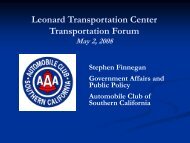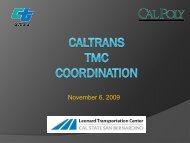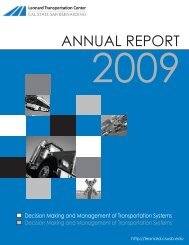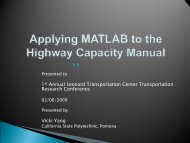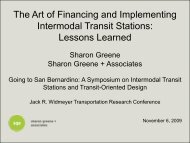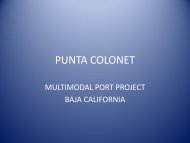Preliminaries to a Feasibility Analysis of the Maglev Proposal of The ...
Preliminaries to a Feasibility Analysis of the Maglev Proposal of The ...
Preliminaries to a Feasibility Analysis of the Maglev Proposal of The ...
You also want an ePaper? Increase the reach of your titles
YUMPU automatically turns print PDFs into web optimized ePapers that Google loves.
4.3 Cost Comparisons: High Speed Rail, <strong>Maglev</strong> and Urban Rapid Transit<br />
If station spacing would not justify <strong>the</strong> high cost <strong>of</strong> high speed ground transportation in terms <strong>of</strong> travel<br />
time savings, what about cost differentials? A syn<strong>the</strong>sis <strong>of</strong> <strong>the</strong> cost information is presented next:<br />
• <strong>The</strong> capital cost estimates for <strong>the</strong> sou<strong>the</strong>rn California system indicate that <strong>the</strong> cost per mile is<br />
approximately $110 million for HSR and $114 for <strong>Maglev</strong> on <strong>the</strong> 80‐km airport connec<strong>to</strong>r<br />
alternative <strong>of</strong> <strong>the</strong> Palmdale line. Alternative alignments <strong>of</strong> <strong>the</strong> IOS show an approximate capital<br />
cost <strong>of</strong> $140 per mile for <strong>Maglev</strong> (SCAG 2002b), a 27% increase over <strong>the</strong> unit cost for HSR.<br />
• Recent cost data from Europe indicate that <strong>the</strong> 2002 cost <strong>to</strong> build a metro line varied widely<br />
upwards <strong>of</strong> $115 million per mile depending partially on efficiencies and partially on whe<strong>the</strong>r<br />
tunneling and aerial structures are involved. (Sunday Business Post, 3/30/2003).<br />
• Similarly, cost <strong>to</strong> build bus rapid transitways varies widely (in 2003 dollars) from $6.5 ‐ $10<br />
million per mile for at‐grade sections and $12 ‐ $30 million per mile for aerial sections <strong>to</strong> $60 ‐<br />
$100 million per mile for sections below grade (FTA, 2009).<br />
<strong>The</strong> data clearly indicate major differences and overlaps. <strong>The</strong> relatively short distances between stations<br />
in <strong>the</strong> planned Sou<strong>the</strong>rn California system make o<strong>the</strong>r fully grade separated, urban rapid transit modes<br />
viable contenders among <strong>the</strong> technological choices. If alignments chosen are feasible with relatively<br />
little tunneling, BRT would be <strong>the</strong> most economical choice in terms <strong>of</strong> capital costs per mile at $30<br />
million or below. If much tunneling is involved, <strong>the</strong>n all capital costs can easily approach or exceed $100<br />
million per mile. In this case <strong>the</strong> rail modes would be more efficient choices. If <strong>the</strong> lower range <strong>of</strong> <strong>the</strong><br />
costs for urban rapid rail (Metro) construction were <strong>the</strong> case <strong>the</strong>n Metro could be an efficient choice. If<br />
<strong>the</strong> upper end <strong>of</strong> <strong>the</strong> costs for Metro construction were <strong>to</strong> be <strong>the</strong> case <strong>the</strong>n HSR would be <strong>the</strong> more<br />
efficient choice. <strong>Maglev</strong> would have <strong>the</strong> disadvantages <strong>of</strong>: (a) higher capital costs than HSR; and (b) <strong>the</strong><br />
inability <strong>to</strong> share existing facilities with o<strong>the</strong>r rail such as AMTRAK and <strong>the</strong> future intercity HSR <strong>to</strong> be<br />
implemented in <strong>the</strong> State <strong>of</strong> California.<br />
21



